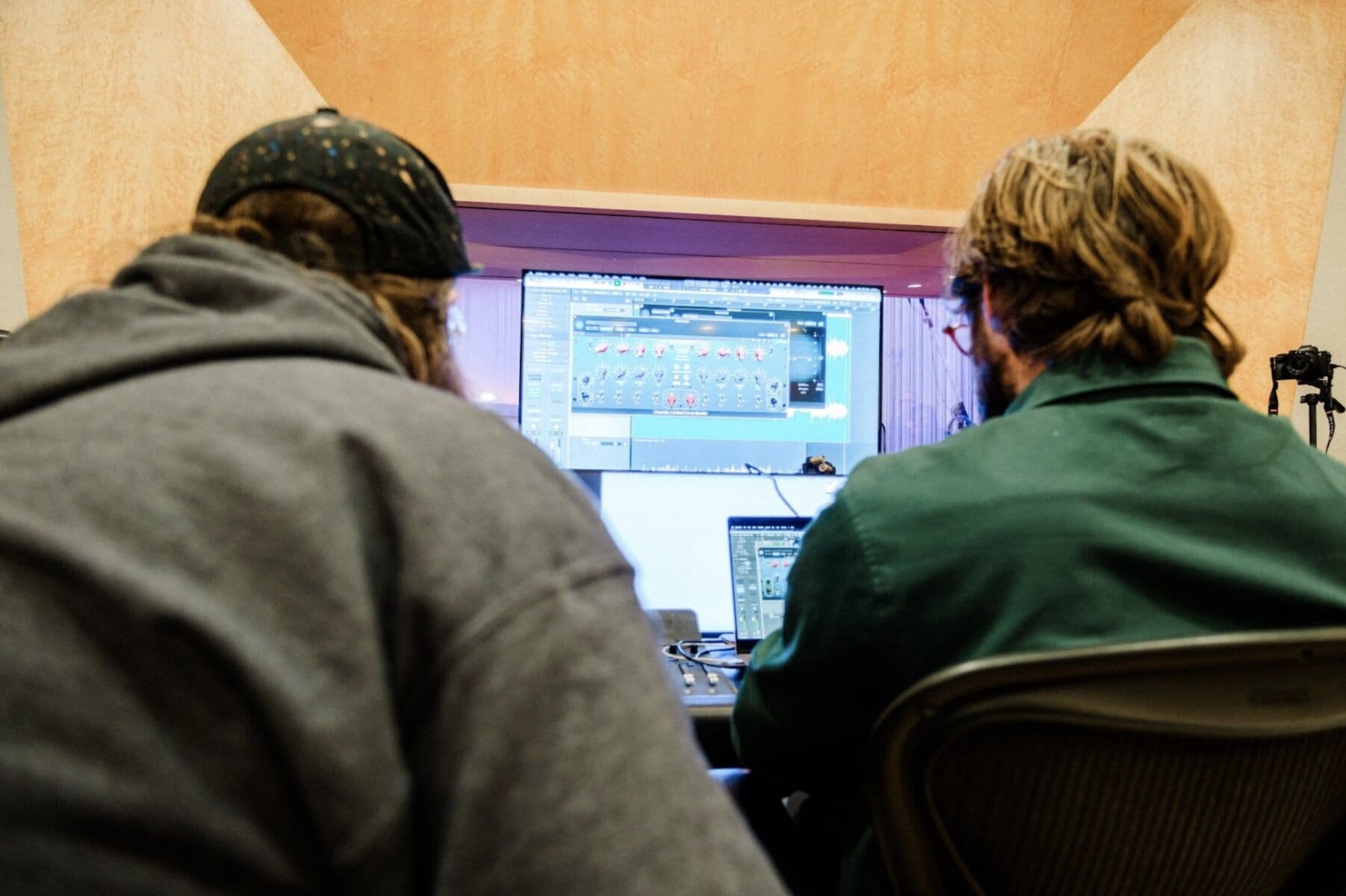A good bassline is critical for a successful song.
Whether you’re working with bass guitar or synths, there are some simple tips you can use to make sure they’re top notch!
To help you get the most out of each tune, I’ve put together this guide to writing your own basslines.
The Role of the Bass
When I first started playing bass, I wanted to play flashy riffs and melodies. I was basically treating it like a guitar.
And while I still love a good bass melody, my early attempts don’t hold up.
The thing is, I wasn’t thinking about what makes a good bassline.
Don’t think about the bass as an individual instrument. Think about it as part of an ensemble. Alongside the drums, it’s the foundation of the entire song.

Without the bass, everything would feel thinner and less powerful.
A good bassline does a few things.
- Establishes the chord progression
- Supports the melody
- Interacts with the drums
- Adds movement to the song
- Shows off your unique style
I’ll be going into all of these in more depth. But first you need to know some basic music theory.
Establishing the Chord Progression – Theory 101
Before you start jamming, let’s learn some background details.
This’ll be a huge time saver, helping you skip over bad ideas and zero in on good ones.
The most important thing to understand is the root.
The Root Note
The root is the lowest note in a chord.
For example, a C major triad is made of a C, an E, and a G. The C is the root.

The root note of a chord is one of the most common notes for the bassist to play. When all else fails, you can hold the root.
The third and fifth are the next most common notes in the bass.
The Third
The third establishes whether the chord is major or minor. By playing the third in the bass, you can help establish how the listener should feel.

But be careful!
When the third is in the bass, it can sometimes sound sour, even though it’s in key. It can also weaken your melody if the vocalist is also on the third.
The Fifth
Tons of bass riffs jump back and forth between the first and the fifth.

It’s a solid option! If you only play the root, things can get stale pretty quickly.
Jumping to the fifth adds movement, and it’s a pretty safe bet for avoiding dissonance.
But it can quickly become predictable! So try not to use it too much.
Octaves
Playing the same note an octave higher or lower can immediately inject energy into your song.
I use this in just about every song I play on.
Sometimes jumping up an octave can cue the audience that the song’s energy is building. On the other hand, jumping down an octave can make a chord feel absolutely huge.
It’s usually a matter of contrast. If you’ve been playing in the higher register, playing lower will feel more impactful.
You can use this to your advantage when pushing into bigger sections.
Want the chorus to feel more exciting? Try jumping the octave.
Scales
Next you need to know your scales.

If you know what scale your song is in, you’ll never have to guess which notes you can play.
Here are the notes for the major scale using C Major to demonstrate:

And the minor scale using A minor to demonstrate:

Make sure the notes you play are in the right scale, unless you’re intentionally jumping ship.
Supports the Melody
You want your bassline to complement the song’s melody.

The melody is the most focal part of the song, what everyone’s paying the most attention to. If your bass doesn’t agree with your melody, it could sink the whole song.
First, think about the rhythm of the melody.
Is it complex or super simple? Whichever the answer is, think about doing the opposite.
This’ll set the melody apart from the bass, allowing it to stand out.
Next, think about the melody’s notes.
Silence
Great bass lines make great use of silence.
If you’re constantly plucking away, chances are you’re taking up way too much space. The bass will drown out the melody.
Try injecting rests into your riffs. Muting the bass on key lyrics is a great place to start.
You may also want the bass to stay quiet for entire sections of the song.
Leaving the bass out for half of a verse is a common arrangement trick. It keeps the verse from feeling too repetitive and builds energy over time.
Repetition
More often than not, some nice repetition is crucial for a memorable bass lick.
This could mean note intervals that crop up again and again or consistent rhythms.
For example, you could slide from the root to the fourth across multiple chords. Or you could play a triplet at the start of each measure.
Whatever you do, try to inject some repetition in your lines. It’ll make things much more digestible for your listeners.
Interacts with the Drums

So what does that mean?
“Interacting with the drums” is intentionally vague.
Oftentimes, the drums and bass should be locked in tight. By playing a really similar rhythm as the drums, you create a strong foundation for the rest of the song.
But sometimes it’s cool when the drums and bass dance around each other. This can bring out the song’s groove.
By filling in blank spaces left by the drums, you can add movement to the song. Just be careful you aren’t getting in the way of the other instruments!
Sync Your Plucks with the Kick Drum
By plucking in time with the kick drum, you can accentuate the rhythmic punch.
This is especially important when you want a certain beat to be particularly powerful. Or if your song is really energetic.
I especially recommend lining your root notes up with the kick. This’ll double down on that punchy effect.
Syncopation
Does the song sound too boring? Add some syncopation!
To put it simply, syncopation is playing notes when you don’t expect them.
Here’s a melody played perfectly in time with the metronome:
And here are those same notes played in a syncopated rhythm:
Sounds more interesting, right? By playing on the off beats you can add more groove to the song.
Remember though, repetition is your friend. You might want to repeat the same syncopated rhythm throughout the song.
Add Movement to the Song

Don’t drag your heels! Your bass part should make the song more interesting, not more boring.
Even slow songs can benefit from a little more movement. You don’t want people to hit skip, right?
Here are a couple tips for adding some intrigue.
Use Passing Notes
Ok, this one isn’t going to be necessary for every bass part. But it’s important enough to include in this guide.
So what are passing notes?
Passing notes aren’t in the actual chord being played. Normally, they’d sound out of place.
But if you play them briefly, sandwiched between two notes that are in the chord, you can avoid that dissonance.
These passing notes can add movement to an otherwise boring bass part. Try bringing them in if your playing feels too “samesy.”
Chord Inversions
The bass establishes the harmonic relationship of every note being played. Whatever note is in the bass is pretty important!
Often that’ll be the root. When other instruments are adding tension, it’s usually best to keep it simple in the bass.
But when other instruments are holding down the root, you have some more wiggle room.
Playing the third can really add some emotional weight. The fifth can be unexpected, keeping the listener on their toes.
Other extended notes are usually best left as passing notes.
Shows Off Your Unique Style
Now that you know the fundamentals, it’s time to think about your style.

There are tons of different ways to play the bass. You can use a pick, your fingers, or slap bass.
You can play loose or perfectly in time. Add tons of movement or keep it sparse.
The list goes on.
Your style will probably draw from several different techniques. And as you keep practicing, you’ll naturally find certain sounds you like.
Which is why I recommend you find some inspiration.
Listen closely to the bass parts of songs you love. Ask yourself, “Is the bass part of why I love this song?”
If so, learn how to play it! This’ll help you internalize the techniques being used.
It might sound a little counterintuitive.
Finding your voice by copying others? But trust me, it helps!
By studying bass parts you love, you’ll start noticing patterns. It’s basically a fast track to figuring out what you think works best.
For me, it was Rage Against the Machine, Daft Punk, and No Doubt. By soaking in their basslines, I had a much easier time learning how to write my own.
So whatever genres you’re working with, find some inspirations and figure out what they’re doing!
Trust Your Instincts

Knowing all this theory is important, but it isn’t everything. Sometimes you need to stop thinking and start playing.
All of the tips above will help you write better basslines. But relying on your intuition can also work wonders.
Of the basslines I’ve written, some of my favorites are ones I didn’t think about at all. I just closed my eyes, listened to the other instruments, and let my imagination do the work.
I’m not saying to just write willy-nilly. You still need to consider what’s best for the song.
I’m suggesting you listen to the song carefully and see what your brain comes up with. You may just hear something that fits perfectly!
Recording Bass Guitar
Once you’ve got your bass part, you’ll probably want to record it.
Make sure you read up on how to record bass guitar if you don’t know how!
Conclusion
By following these simple tips, you can write incredible basslines for your songs!
But no matter what you do, make sure it serves the song!
Playing flashy riffs is fun. But at the end of the day, the only thing that matters is how it sounds in the context of the song!














